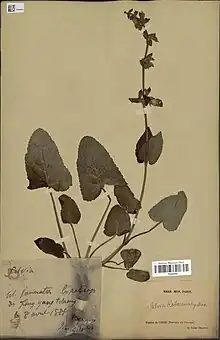Salvia roborowskii
Salvia roborowskii is an annual or sometimes biennial herb that is native to a wide area that includes Tibet, Sikkim, and five provinces in China, growing on wet stream banks, grasslands, and hillsides between 8,000 and 12,000 feet elevation.
| Salvia roborowskii | |
|---|---|
 | |
| Scientific classification | |
| Kingdom: | Plantae |
| Clade: | Tracheophytes |
| Clade: | Angiosperms |
| Clade: | Eudicots |
| Clade: | Asterids |
| Order: | Lamiales |
| Family: | Lamiaceae |
| Genus: | Salvia |
| Species: | S. roborowskii |
| Binomial name | |
| Salvia roborowskii | |
Growing up to 3 feet tall in the wild, Salvia roborowskii has triangular rosemary-green leaves that cover the upright plant. The leaves have scalloped edges, have a hairy surface, and are indented with veins. The 0.25 inch lemon-yellow flowers grow out from a rosemary-green calyx, with 8-12 flowers per whorl. Only a few flowers are in bloom at a time.[1]
Notes
- Clebsch, Betsy; Barner, Carol D. (2003). The New Book of Salvias. Timber Press. p. 250. ISBN 978-0-88192-560-9.
This article is issued from Wikipedia. The text is licensed under Creative Commons - Attribution - Sharealike. Additional terms may apply for the media files.